
California State University, San Bernardino California State University, San Bernardino
CSUSB ScholarWorks CSUSB ScholarWorks
Electronic Theses, Projects, and Dissertations O=ce of Graduate Studies
8-2022
SOCIAL MOBILE APPLICATION: UDROP SOCIAL MOBILE APPLICATION: UDROP
Mahmoud Oraiqat
Follow this and additional works at: https://scholarworks.lib.csusb.edu/etd
Part of the Science and Technology Studies Commons
Recommended Citation Recommended Citation
Oraiqat, Mahmoud, "SOCIAL MOBILE APPLICATION: UDROP" (2022).
Electronic Theses, Projects, and
Dissertations
. 1539.
https://scholarworks.lib.csusb.edu/etd/1539
This Project is brought to you for free and open access by the O=ce of Graduate Studies at CSUSB ScholarWorks.
It has been accepted for inclusion in Electronic Theses, Projects, and Dissertations by an authorized administrator
of CSUSB ScholarWorks. For more information, please contact [email protected].

SOCIAL MOBILE APPLICATION: UDROP
A Project
Presented to the
Faculty of
California State University,
San Bernardino
In Partial Fulfillment
of the Requirements for the Degree
Master of Science
in
Computer Science
by
Mahmoud Oraiqat
August 2022

SOCIAL MOBILE APPLICATION: UDROP
A Project
Presented to the
Faculty of
California State University,
San Bernardino
by
Mahmoud Oraiqat
August 2022
Approved by:
Bilal Khan, Advisor, Computer Science
Jennifer Jin, Committee Member
Haiyan Qiao, Committee Member
© 2022 Mahmoud Oraiqat
iii
ABSTRACT
Udrop is meant to be a global platform to seamlessly deliver content by
simply “dropping” content at designated locations for select users. Users can
drop content in the form of texts, short videos, and pictures, which users will then
be able to share with their friends. Udrop features will provide an interactive user
experience for users to socialize and expand their social circles. Udrop ensures
scalability, reliability, and a manageable innovative social application by using
cloud services. Currently Udrop is in a beta-trial with 10 to 20 users generating
anywhere from 5 to 15 records, drops, per user. Udrop’s end-user interface and
internal system design ensure that user requirements such as low latency, clear
graphical design, and reliable service are addressed. Udrop will provide
everyday social media users a new take on how their social media can provide a
more meaningful interaction with their audience.
iv
TABLE OF CONTENTS
ABSTRACT .......................................................................................................... iii
LIST OF FIGURES ...............................................................................................vi
CHAPTER ONE: INTRODUCTION ...................................................................... 1
Background ................................................................................................ 1
Significance ............................................................................................... 1
Purpose ..................................................................................................... 2
Scope......................................................................................................... 3
CHAPTER TWO: OVERALL DESCRIPTION ...................................................... 4
Product Perspective ................................................................................... 4
User Interfaces ................................................................................ 4
Cloud Services ................................................................................ 5
Communication Interfaces .............................................................. 5
Memory ........................................................................................... 5
Operation ........................................................................................ 6
Security ........................................................................................... 6
Product Functions ...................................................................................... 6
Users ......................................................................................................... 8
Constraints ................................................................................................. 9
Class & Use Case Diagrams ..................................................................... 9
Specific Requirements ............................................................................. 11
User Interfaces .............................................................................. 12
v
Software Interfaces ....................................................................... 13
Function Requirements ................................................................. 14
Performance Requirements .......................................................... 16
Design Constraints ........................................................................ 16
Software System Attributes ........................................................... 16
Assumptions and Dependencies ............................................................. 16
CHAPTER THREE: USER TEST CASES .......................................................... 17
Test Case 1: User Authentication ............................................................ 17
Test Case 2: Interacting with Friends ...................................................... 21
Test Case 3: Sending a Drop to Users .................................................... 25
REFERENCES ................................................................................................... 34
vi
LIST OF FIGURES
Figure 2.1 Udrop Client Flow Chart Between Cloude Services. .......................... 7
Figure 2.2 Udrop Interface Flow Map. ................................................................. 8
Figure 2.3 Class Diagram. ................................................................................... 9
Figure 2.4 UML Use Case Diagram. .................................................................. 10
Figure 3.1 Login Page And Create Account Pag. .............................................. 19
Figure 3.2 Mongo DB Users Portal.. .................................................................. 20
Figure 3.3 User Inputting Additonal Information. ............................................... 21
Figure 3.4 Home And Friends Page. ................................................................. 23
Figure 3.5 Change In Friend Status. .................................................................. 24
Figure 3.6 Actions For User Jeffry.. ................................................................... 26
Figure 3.7 Drop Creation Page .......................................................................... 27
Figure 3.8 Drop Media Page After Providing A Custom Location.. .................... 29
Figure 3.9 Home Page After Sending A Drop To User Jeffry.. .......................... 30
Figure 3.10 Notification And Home (Locked) Page.. .......................................... 31
Figure 3.11 Drop Location And Home (Unlocked) Page.. .................................. 32
Figure 3.12 Comments Page.. ........................................................................... 33
1
CHAPTER ONE
INTRODUCTION
Background
Social media apps are being published every day; however, the majority
seem to branch further and further away from reality. This is in a large part due to
how enticing socializing has become through technology. Popular apps such as
Facebook, Instagram, or Twitter allows user to send and receive their social
media with the push of a button. Although users are guaranteed convenience,
these applications are depriving users from physical interaction. Udrop attempts
to bridge the gap between the virtual and real world by essentially allowing their
users to send virtual care packages within the real world for the users to retrieve.
This will allow users and their friends to have a more meaningful interaction with
one another, an interaction that will not end at the press of a button. Udrop allows
users to receive messages when and where they need them.
Significance
Udrop will be a new platform for everyday app users to have a more
meaningful interaction with their audience. This will be achieved by allowing user
to receive message when and where they need it.
Although Udrop is categorized as a social media platform, there is no
limitation to a user’s creativity when creating a drop. Drops can used as the
2
medium to make their everyday social media post more meaningful for them and
their audience.
Udrop will one day be published on the Google Play and App Store for
distribution.
Purpose
Udrop is being developed for users that want more from their social media
apps. Udrop will allow users to drop messages in the form of text, images, or
short videos to recipients at designated locations to be collected. Depending on
the designated location a user specifies, users can provide a meaningful
interaction with their media drop. For example, say a user walked into a grocery
store, they check their phone, and they notice they unlocked a Udrop message.
The message contains a grocery list that their significant other had verbally
mentioned to them that morning. However due to a long workday this user forgot
everything they were told. Fortunately, their significant other sent them a drop
with the grocery list at the store’s location in case they forgot when they arrived
at the store. Now, said user can send a confident message back in the form of a
comment, notifying their significant other mission complete. In this scenario the
social media message had a significant role in a trip to a grocery store.
The objective of this project is to build an application prototype by
implementing the required features requested by the client and ensuring
3
scalability. This document will define the app’s functionalities, limitations and
requirements provided by the client.
Scope
Udrop’s user interface (front-end) includes the following well-standard
pages: Home, Friends, Account, Drop Location View, Create Drop, Login, Create
Account, Notifications, and splash pages. The pages will be functional, easy to
navigate, and provide the same aesthetic in both iOS and Android platforms.
Udrop will use cloud service technology to handle all server (back-end)
functionality to manage user data and client connections. The main objective of
this project is to provide a working, scalable, prototype where all application
features and functions are implemented.
As Udrop is a social media platform, Udrop’s design will encompass a
way for users to expand their network. Udrop will enhance social interactions by
connecting people through a mutual friends drop. Allowing users to share their
ideas and display names through a drop’s comment section.

4
CHAPTER TWO
OVERALL DESCRIPTION
Product Perspective
Udrop is a standalone application that will provide users a social media
service. Udrop will allow users to send and receive drops in the form of a
message, image, or short video. These drops will be a user creation and will be
sent to their designated receiver with a specified location.
The application is designed in a way where users have the option to send
a drop to multiple users thus bringing people together at the drop location. Once
the drop is received users are then able to provide feedback by leaving a
comment that all user who received the same drop will be able to view.
To get desired functionality, Udrop will have one main component in the
form of a client which will connect to multiple cloud services. The client will be
responsible for all user interface components and communication between the
cloud services through SDKs. The cloud services will then manage data, client
connections, and user requests by using their respective development
tools/services.
User Interfaces
Udrop’s user interface (front-end) includes the following pages: Home,
Friends, Account, Drop Location View, Create Drop, Login, Create Account,
Notifications, and splash pages. The pages will be functional, easy to navigate,
and provide the same aesthetic in both iOS and Android platforms. Within

5
selected pages, the client will communicate with cloud services to dynamically
update specific viewing components with the latest user data.
Cloud Services
There are four main cloud services that will be used for the development
of Udrop:
1. React Native IDE (Client-Side development)
2. MongoDB’s Realm (NoSQL, and Serverless Architecture),
3. AWS (media storage using S3 Simple Storage)
4. Google Maps API (google maps service).
Communication Interfaces
Communication between services will be handled through embedded
SDKs within the React Native client to handle different functionality. The client
will then manipulate data between the services to provide a cohesive system
between SDK functionalities.
Memory
Udrop will use physical resources provided by cloud services MongoDB,
and AWS S3. The amount of memory used will follow cloud services storage
model where Udrop’s available storage will scale in accordance with the amount
used.
On physical devices, Udrop will require 90 MB in storage space to
download the app. Udrop will be able to run on any smart device with Android or
IOS operating system.

6
Operation
Udrop implements Serverless Architecture where all underlying
infrastructure is being handled by the cloud services. MongoDB’s Realm provides
serverless computing using functions, saving data to MongoDB’s Atlas (NoSQL
solution), and provides user authentication. While AWS S3 will store pictures
and videos that be can readily accessed through URL links. By using these cloud
services Udrop can ensure cost efficiency, elastic scalability, rapid iteration, low
administrative overhead, and developer productivity.
Security
Since users will be meeting within at a physical location security must
addressed accordingly so that users won’t be put into risky situations. Although
users are responsible for adding Friends they trust, Udrop may provide a way to
authenticate identity before accepts any drops from users they may not fully trust.
A potential solution would to be in the form of a text-message authentication or
email authentication. Once user authenticate one another they will be allowed to
send drops to one another.
Product Functions
Udrop follows a microservices model where the different cloud services
are independent from one another as shown in Figure 2.1. The user interface will
provide multiple pages that the user can navigate between to access different
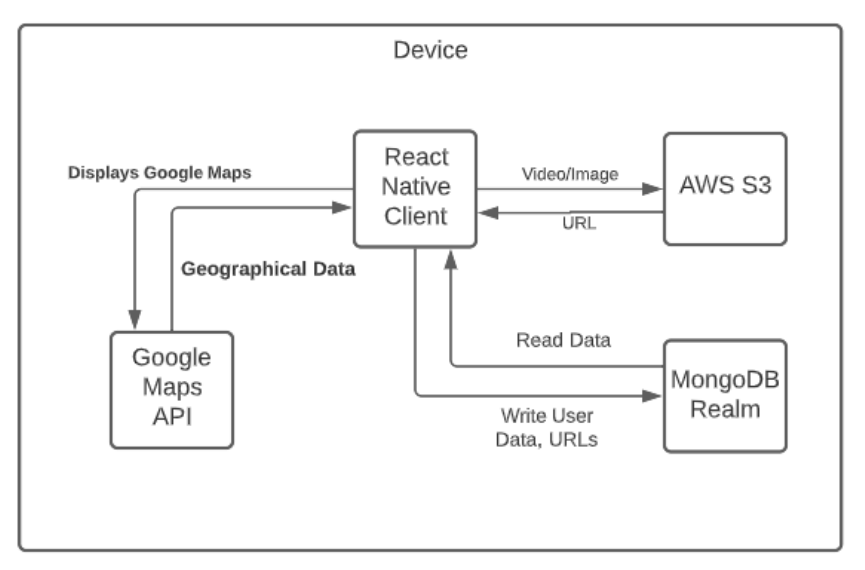
7
features of Udrop.
Figure 2.1. Udrop Client Flow Chart Between Cloud Services.
An overview of how a user will interact with Udrop’s interface is show in
Figure 2.2. Majority of the arrows shown below are double sided indicating that a
user will be able to go back and forth between pages. However, there are some
cases where the client determines which page to present to the user based on
their user data. For example, if the user’s data confirms that the user signed in
with a new account, they will be automatically navigated to Account Setup.
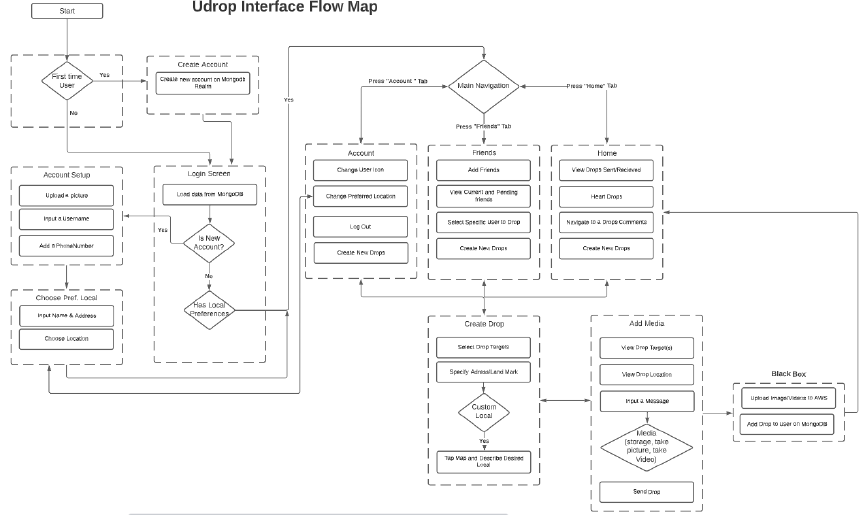
8
Figure 2.2. Udrop Interface Flow Map
Users
The general users of Udrop are individuals who would like to connect with
friends, family, fans, followers, or likeminded individuals. Udrop is designed to
provide a fresh take on social media interaction and will be available to any
individual with a smart device. The target audience are those that would like their
discourse to be more involved with the content they share. Similarly, Udrop is
meant for users that would like to be proactive in receiving new content from
those that they admire most such as friends, family, or even celebrities. It should
be mentioned that there is currently no restriction on a user’s age.
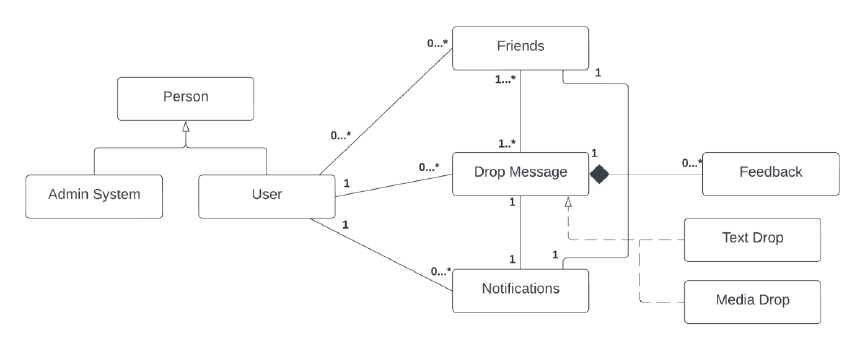
9
Constraints
• Udrop messages will be deleted after a 30-day period, which will be
unretrievable to the user.
• Udrop is intended to be a free application but will include the use of
google ads.
• Other constraints to this project are providing reliable scalability,
cost efficiency, and a great user experience.
Class & Use Case Diagrams
The Class Diagram (Figure 2.3) provides a visualization of the relationships
between Users, Friends, Drop messages, and Notifications classes. Users will
typically have zero to many Friends, Notifications or Drop Messages depending
on their activity. While Drops can have media content and may have feedback in
the form of a “Heart” or a Comment.
Figure 2.3 Class Diagram
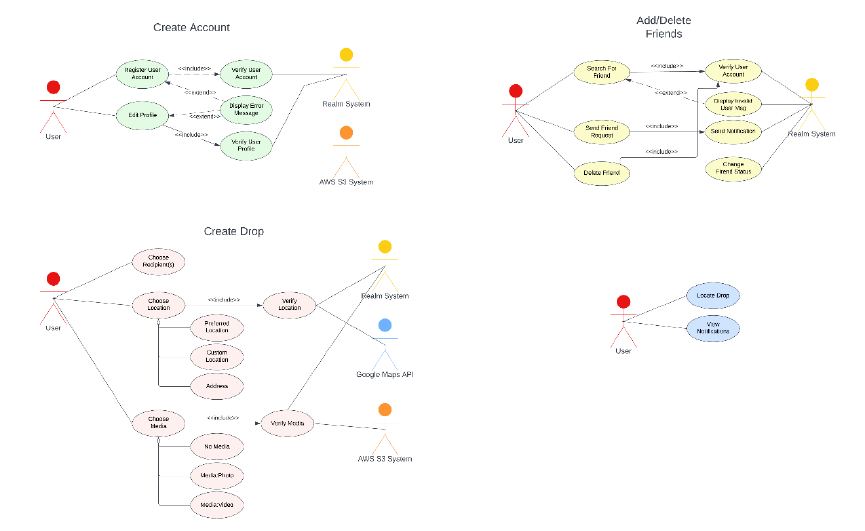
10
Figure 2.4 UML Use Case Diagram
The Use-Case Diagram (Figure 2.4) shows the interactions between a
Udrop’s system and environment.
1. Realm System: is responsible for registering users and Editing User
Profiles
a. Register new account: Realm System receives an account
registration request and accepts/rejects after verifying submitted
credentials.
b. Edit User Profile: Realm System verify permission levels and
update user information.
11
c. User Validation: Realm System will verify users and their
permission level to allow access to data.
2. User: is responsible for dealing with all functionalities below.
a. Register with Udrop: A user requires registration with verifiable
credentials to use Udrop.
b. Add/Delete Friends: Users can send friend requests or delete
friends on Udrop.
c. Create a Drop: Users with friends can create drops that are
attached with media or text that will be retrieved at a specified
location.
d. Locate Locked Drops: Users who received a drop will be able
to locate a drop to unlock it.
e. View Notifications: Users can view friend requests or drop
notifications.
3. AWS S3 System: is responsible for verifying profile or media data.
4. Google Map API: is responsible for validating all geographic locations.
Specific Requirements
All pages should provide a good user experience and reliable
functionality. User’s experience is expected to increase with well-designed pages
and interactive graphical components like buttons, scroll wheels, or dropdown
menus. While functionality should be implemented such that all fail cases are
handled and functionality is persistent.

12
User Interfaces
1 Login Page: Allows the user to sign into their account, then navigate to the
user to the homepage. If the user does not already have an account, the user
can navigate to the Create Account Page (Figure 3.1 Left).
2 Create Account Page: Allows new users to create an account by submitting
an email, and password to be associated with their account. Once account is
successfully created, user will be taken to Login Page (Figure 3.1 Right).
3 Welcome Page: Allow first time users to setup their account by providing a
user icon, display name, and phone number. Once data is submitted
successfully, users are directed to Preferred Location Page (Figure 3.3 Left).
4 Preferred Location Page: Allow users to provide a location they would prefer
to go to access their drops. The preferred location can be changed at any
time by navigating to the Account Page (Figure 3.3 Right).
5 Home Page: Allows the users to see their drops and navigate to Account or
Friends page. There is also a floating button to navigate to Drop Creation
Page at any time. Users can also navigate to a Drop’s comment page view
comments (Figure3.4 Left).
6 Account Page: Allows users to change their profile picture, update their
preferred location, and log out. There is also a floating button to navigate to
Drop Creation Page at any time (Figure 3.9).

13
7 Friends Page: Allows users to view friends, add friends, delete friends, and
select a friend to drop to. There is also a floating button to navigate to Drop
Creation Page at any time (Figure 3.4 Right).
8 Drop Creation Page: Allows users to choose/modify their target user(s) and
specify drop location from three options (Figure 3.7).
9 Add Media Page: Allow users to provide a message or media in the form of
pictures or videos (Figure 3.8).
10 Drop Location Page: Allow users to toggle between their real time location
and the drop location on a google map. Once users are within 30-meters,
they will be directed to the Home Page to view the drop (Figure 3.11 Left).
11 Comments Page: Users can leave a comment for their sender or other
individuals who are viewing the same drop (Figure 3.12).
12 Notification Page: Allows users to view their notification that are generated
from receiving new drops or friend requests (Figure 3.10 Left).
Software Interfaces
Account and Media Page have access to the AWS S3 SDK to upload their
user icon profile and any media they wish to attach to their drop. The return data
from AWS S3 will be in the form of a URL link that will then be saved to
MongoDB Atlas through the MongoDB Realm SDK. The React Native client will
provide a realm instance where data will be synced between all client
connections. This allows users to received real time updates when there is a
relevant change to user data: receiving notifications and drops from other users.

14
Lastly, the React Native client leverages Google Map API to display locations,
set location markers, and view the 30-meter range around a drop location for
specific pages.
Function Requirements
1. Authenticating Users: Udrop will authenticate users by allowing them to
create an account using an email and password. Once the account is
created the user will then be able to setup their account by providing a
profile image, display name, preferred drop location ,and phone number.
All data is saved in their respective unique user documents within the
database.
2. Choose a Drop Location: Users will be able to send drops to one or more
friends that are registered in their Friend’s List. Once the drop target(s) are
identified, the user will then choose one of three options to indicate the
drop location. Firstly, users have the option to send a drop to their
target(s) preferred locations. Secondly, users can provide an address that
they would like to drop to. Finally, they can select an exact location on a
map and provide a custom description of their desired drop location. Also,
as an added feature users will be able to see their recent drop locations
and “favorite” their favorite drop locations.
3. Adding Media to Drop: Once users choose a drop location they are then
able to add a message and/or media to their drops. The media can be in
15
the form of a picture or a 10 second video that they can either take in the
moment or choose from their device’s storage.
4. Add/Delete Friends: Users will be able to add friends by providing their
friend’s email or display name. Once the friend request is sent, they will
see a relationship status of “pending” within the Friends Page. The
recipient of the friend request will then decide whether to accept or deny
the friend request. Once users become friends, each user has the power
to unfriend one another. Any changed made to the relationship status
within the friends list will be updated in real time for both users.
5. Unlocking a Drop: Once a user received the drop the user must be in the
30-meter ranged of the specified location to unlock the drop. Unlocking the
drop allows the user to see the contents of the drop from the sender.
Users can then “heart” or comment on the drop within the comments
page.
6. Change Preferred Location and Profile Image: Users can navigate to the
Account page to change their preferred location and profile Image.
7. Handling Notification: Notifications are generated when a user received a
new drop or friend request. User can accept or deny the friend request
only in the Notification Page. While the drop notification will navigate the
user to the Drop Location Page to toggle between their location and the
drop location. Once a notification is interacted with, they are then deleted.

16
Performance Requirements
Udrop will be available on the App Store and Google Play and expect to
run on most versions of Apple iOS and Android. The backend must be able to
handle many requests with low latency, scalable storage and efficient in-app data
processing.
Design Constraints
Udrop will be designed in React Native for multi-platform support, so page
components must be formatted reliably so that regardless of the device used the
pages will look consistent.
Software System Attributes
Udrop messages can only be retrieved if the specified recipient is in the
designated drop zone. Users should not be able to see what the user sent until
the drop is unlocked.
Drops can only be sent to friends that have already accepted the friend
request. User should not be able to see friends with a “pending” status within the
dropdown menu within the Create Drop Page.
Assumptions and Dependencies
The assumption can be made that the user will provide Udrop access to
the internet and geological location for the application to send/receive messages,
and utilize different features as intended. In addition, users are expected to have
a basic familiarity of enabling their GPS and finding desired locations on a map.
17
CHAPTER THREE
USER TEST CASES
Test Case 1: User Authentication
Test Case Objectives:
1. Udrop should be able to process new users by providing a
simplistic and easy to follow account creation procedure.
2. Once an account is created Udrop’s client must determine whether
the user is a first-time user or a returning user. If the user is new to
the Udrop platform, allow user to fill in additional account
information. Otherwise, if the user is a returning user, direct them
directly to their home screen to view their drops.
3. On Udrop’s Realm Instance (MongoDB Cloud Service), once users
are authenticated, the Realm instance must create an empty user
object within the database ready for user data to be uploaded.
4. Users should not be able to create an account with an invalid email
address or an empty password. Similarly, user should not be able
to login with invalid credentials.
Expected Results: Udrop fulfilling all test case objectives and displaying
all features in a visually pleasing and practical manner. There should not be any
visual components leaving the user guessing on their respective function or
purpose.
18
Process and Actual Result: Udrop will automatically be on the sign-In
page when user open the app. Users are then able to locate and navigate to the
create account page as shown in Figure 3.1. Users will then fill in their desired
email and password they would like to associate with their account. Once users
tap “Create Account”, the client will interact with MongoDB Realm SDK to create
a new user with the email and password provided, while also creating a new user
object. New users will now be added to the list of authenticated users as shown
in Figure 3.2.
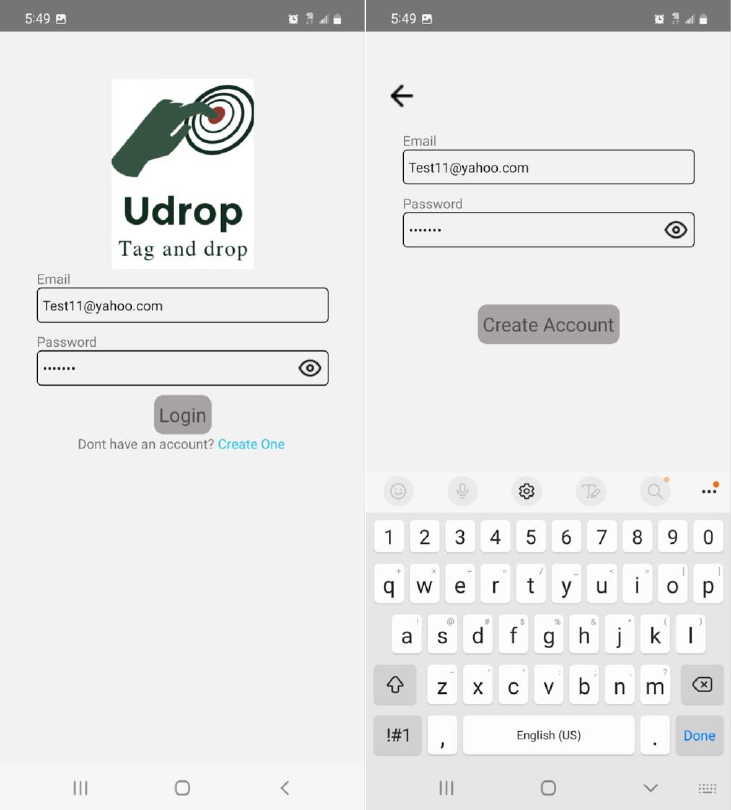
19
Figure 3.1: Login Page And Create Account Page
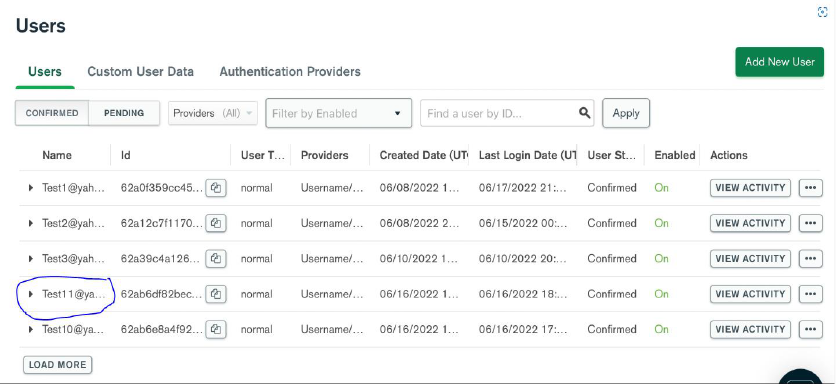
20
Figure 3.2: Mongo DB Users Portal.
Once the Realm instance is successful, the client will then navigate back
to user login, where user can sign into their new account. Udrop will complete
new User creation by navigating users to the Welcome page where users can
provide a display name, phone number, and choose a preferred location. Once
additional formation is verified on the Realm Instance, user is navigated to the
home page to continue their Udrop experience.
Users are presented an alter window describing errors in regard to their
credentials if the following conditions are violated: Empty email or password field,
account does not exist, or incorrect email/password.

21
Figure 3.3: User Inputting Additional Information. (Using A Fake Phone Number)
Test Case 2: Interacting with Friends
Test Case Objectives:
1. Users should be able to add or delete one another from their
Friends page. This entails finding another user with the same email
or display name provided by the client’s user.
22
2. Users should not be able to add one another if users are already
friends or if the email/display-name provided is not found in the
database.
3. If a recipient declines a friend request, this change should be
conveyed to the user by delete the pending request from the user’s
friend list.
4. Users should be able to delete any friend on their friends list. The
Udrop must update both users of the change in their friends list
after deletion is successful.
Expected Result: Udrop will be able to add users using an email or
display name. Alert the user to any errors such as an invalid email or display
name. Update Udrop’s user interface when requests are successful and there is
a change in a user’s friend list.
Process and Actual Result: Users can begin adding friends by
navigating to the Friends page from their Home page then tapping the “Add
Friend” button located at the top right of the screen. A pop-up widget will allow
users to input an email or display name to add (Figure 3.4). If the user is found,
the pop-up widget will close, and the friends list will populate a new friend
component displaying the desired user’s display name with a pending status.
However, if the user is not found, the pop-up widget will display red text
indicating the failed request, allowing users to try again. Once the recipient

23
accepted the friend requests both users will see the change within their Friends
Page respectively (Figure 3.5).
Figure 3.4: Home And Friends Page
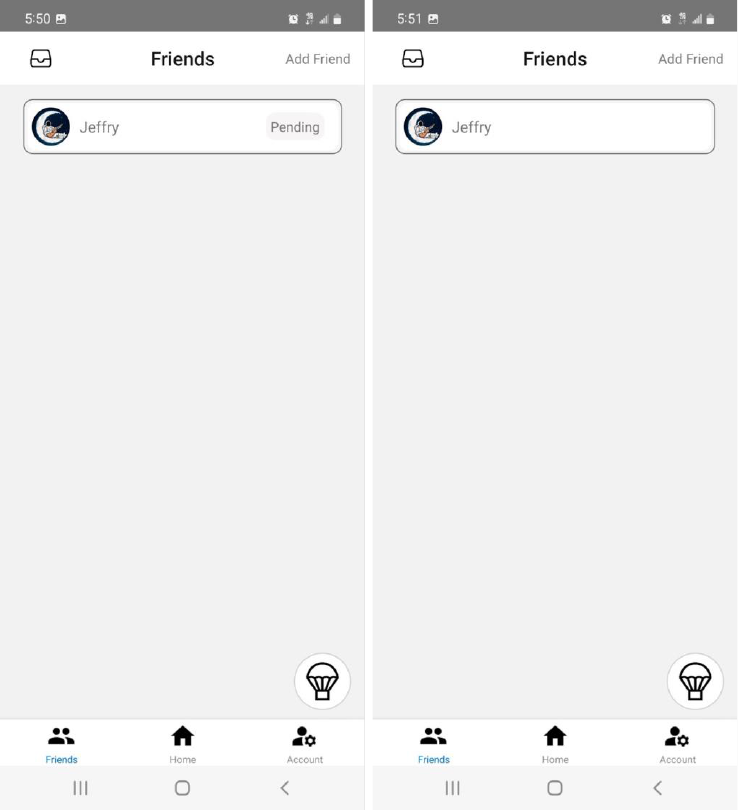
24
Figure 3.5: Change In Friend Status.
Users will also be able to delete a friend by tapping on the user’s friend
component they wish to delete and press “Unfriend” on the pop-up widget (Figure
3.6). This will remove one another as friends between both users. Users would
then have to request another friend request to become friends again.
25
Test Case 3: Sending a Drop to Users
Test Case Objective:
1. Users can send a social media drop to one or many of their friends.
2. Users can choose from three different options when specifying the
drop location: their target(s) preferred location, a specific address,
or a specific location where they provide a custom description of
the drop zone.
3. Users can also reuse a recent drop location or a favorite location.
4. Users should not be able to proceed to the next step in drop
creation without providing choosing recipients or a drop location.
5. Users will then be required to provide a message and given the
option to attach a picture or 10s video.
6. Lastly the client should not direct the client until any media is saved
within the database and is readily accessible.
Expected Results: Udrop will meet all requirements listed above while
maintaining a visually pleasing user interface. Any conditions that have not been
fulfilled will promptly notify the user to make corrections. Lastly, all visual
components are easily identifiable, and their functionality are clear.
Procedure and Actual Results: Users will first need to choose a friend to
send a drop to. This can be done in two ways, the first being navigating to the
“Friends” page and tapping the friend widget and selecting “Send Drop”(Figure
3.6). This will direct the user to the “Create Drop” page where their specified

26
recipient is selected. Another option would be to press the floating “+” button
found on any primary page (Home, Friends, Account). This will direct users to the
“Create Drop” page where users can click another “+” button which will open a
pop-up widget displaying their friends list (Figure 3.7).
Figure 3.6: Actions For User Jeffry.
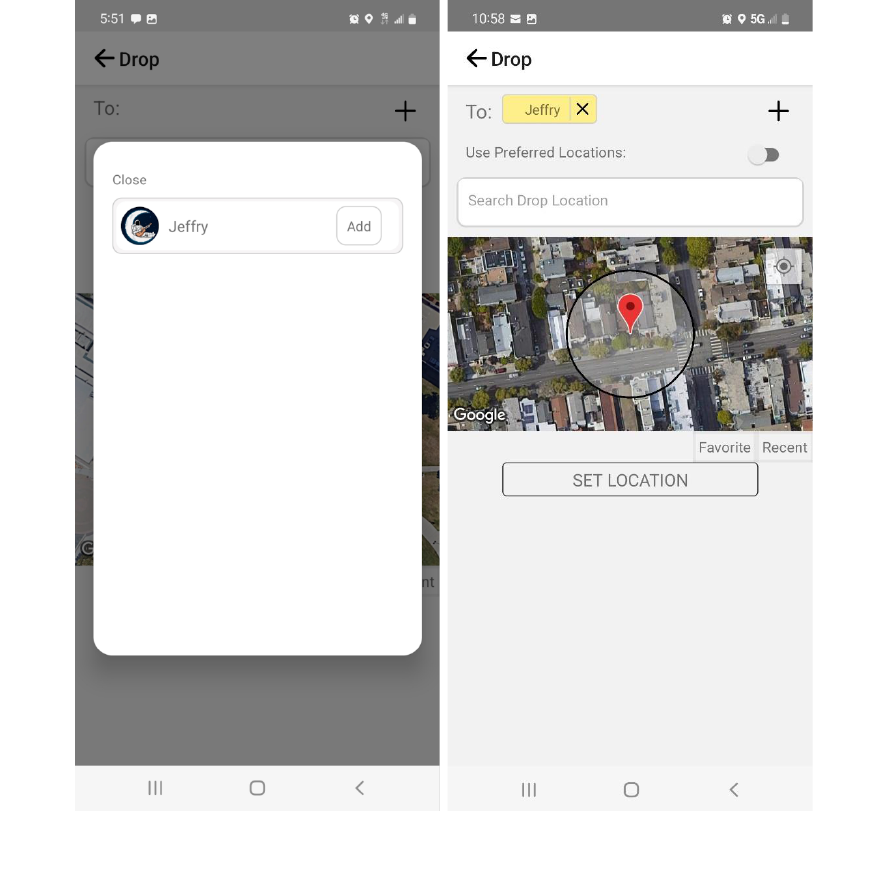
27
Figure 3.7: Drop Creation Page.
Once the recipient field is no longer empty, users can then choose their
desired drop locations from three options. First, users can send their drop to their
recipients’ preferred drop location by clicking the toggle button provided. If the
toggle button is enabled all other options will be visually unavailable until the
toggle is switched off. Secondly, users can provide an address they would like to
send their drop to, which will update the google map to display their desired
28
address location. Lastly, users can choose a location anywhere on google maps
and provide a custom description of their desired location. If users have already
sent a drop before they can also choose a recent or favorites drop locations.
Once users are satisfied with their drop location, users can then tap the
“Set Location” Button found on the bottom of the screen (Figure 3.7 Right). Users
will then be directed to the Add Media page where they are required to add a
message. Users can also add Media in the form of a picture or a 10s video that
can be taken in the moment or selected from their device’s storage. In Figure 3.8,
it can be seen how the user interface adapts to adding the media content to the
drop. Users have the option to remove the media by tapping the “X” next to the
content container. It should be noted that if users do not provide a message, the
Udrop’s client will alert them to provide one.
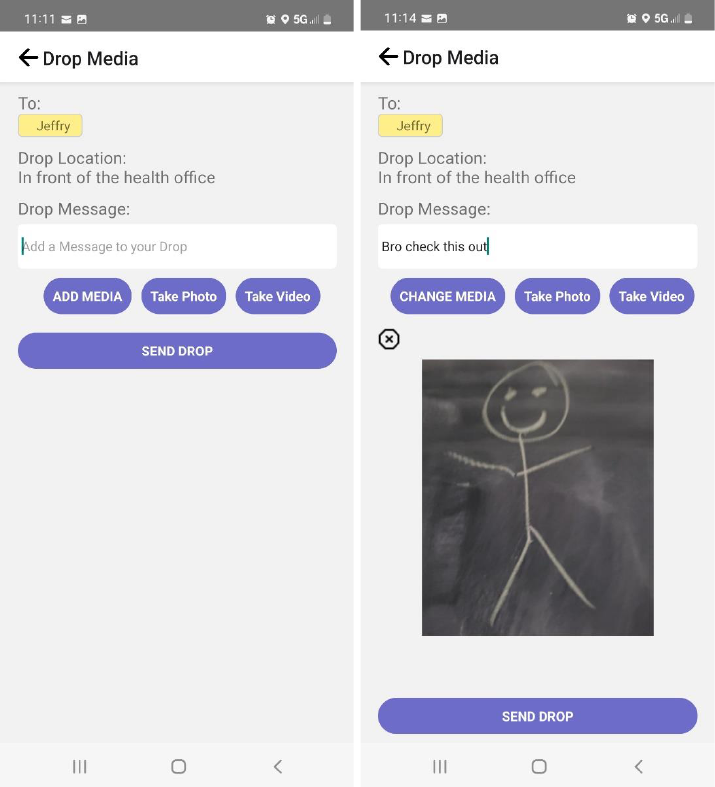
29
Figure 3.8 Drop Media Page After Providing A Custom Location.
Finally, once the user is satisfied with their drop they can press “Send
Drop” where depending on the size of their content, they will see a loading
screen. The loading screen indicated that Udrop is still uploading content to
Udrop’s backend. Once this is completed users will be taken to the home page
where they can see their newly created drop (Figure 3.9).

30
Figure 3.9: Home (Update) And Account Page.
Now that the drop has been sent, the receiver will be notified
immediately and populate their notification page with a new notification. The
receiver can then navigate to their notification page via a local phone notification
(Figure 3.10 Left) or view the drop from the home page (Figure 3.10 Right).
Using either method, the receiver will be able to navigate to the drop location
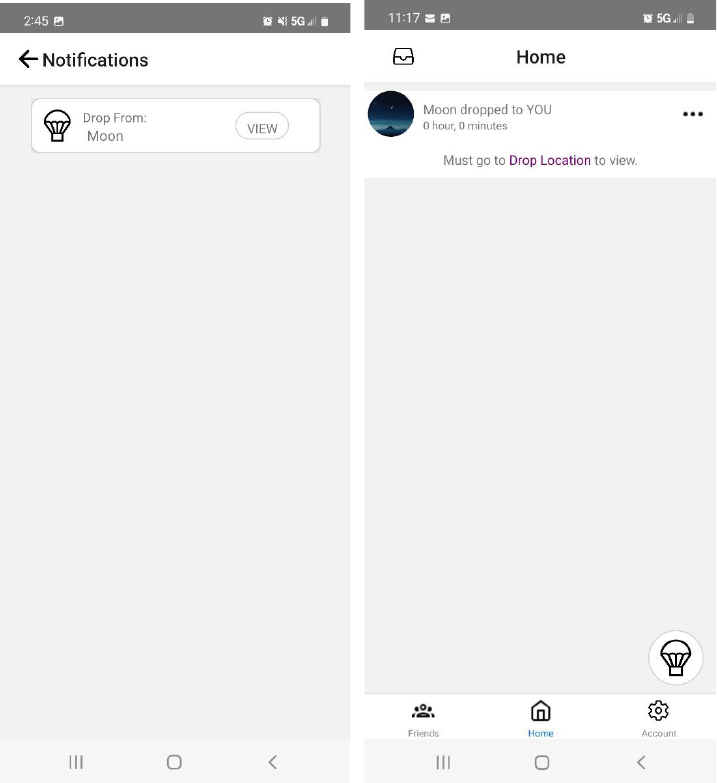
31
page (Figure 3.11 Left) where they will be able to view their location and the
drop location. Once the user is within the 30-meter range of the drop, indicated
by the drop zone graphical component, the receiver will be automatically directed
back to the home page with an unlocked drop (Figure 3.11 Right). Both users,
the sender and receiver, will be able to provide feedback on the drop using the
corresponding comments page (Figure 3.12)
Figure 3.10 Notification And Home (Locked) Page.
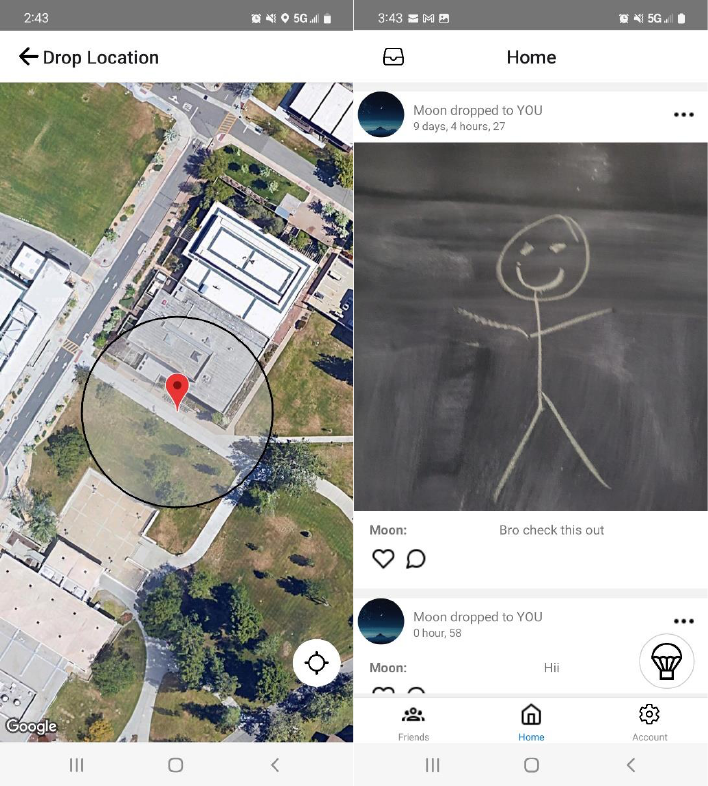
32
Figure 3.11 Drop Location And Home (Unlocked) Page

33
Figure 3.12 Comments Page.
34
REFERENCES
“Mongodb Realm.” MongoDB,
https://www.mongodb.com/developer/products/realm/.
“React Native · Learn Once, Write Anywhere.” React Native RSS,
https://reactnative.dev/.
“S3.” Amazon, Strand Street Press, 2002, https://aws.amazon.com/s3/.
